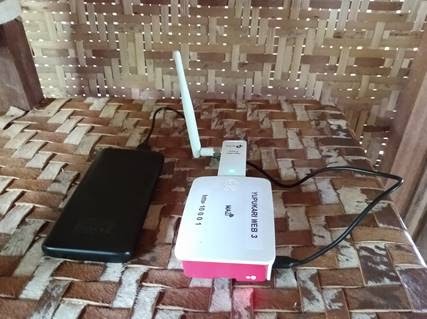3.8 Network sharing
| Site: | OpenLearn Create |
| Course: | 3 Digital Skills |
| Book: | 3.8 Network sharing |
| Printed by: | Guest user |
| Date: | Friday, 21 November 2025, 12:16 AM |
1. Introduction
People are increasingly using smartphones and other devices for recording, analysing and reporting on local information. It is common for this information to be shared via email, on social media or on websites, but this requires Internet access. However, many community members do not have access to the Internet, or when Internet access is possible, this can be expensive. In addition, some community members may prefer not to upload local information onto the internet for security and privacy issues, and may instead prefer to only make this information available to others living within their locality.
People can share information from device to device without the need for Internet access using Bluetooth. However, this does depend on two devices being in close proximity. Another major limitation of using Bluetooth for sharing information is that there is no central repository of the information that is easily and quickly accessible by everyone.

2. DIY Networks
An alternative solution is a DIY network. A DIY network is a local wifi zone independent of the Internet. The key component of such a network is a computer unit that acts as a ‘server’ which can be accessed through a wifi signal that the unit broadcasts. Anyone with a phone, tablet or laptop can access the information available within the DIY network if they are in range of the wifi signal.
The video below gives an example for such DIY networks from the project MAZI, which created software and toolkit for setting up local DIY networks. The project MAZI has since ended, but there are alternative software you can use for setting up such networks, for example DietPi.
One of the most popular computer units for DIY networking is a Raspberry Pi – an extremely cheap computer originally developed in the UK to promote teaching of basic computer science in schools. Raspberry Pi computers are now used for all sorts of applications, including DIY networks. As of March 2018, 19 million Raspberry Pi units have been sold worldwide. Not all Raspebrry Pi models are made with Wifi capabilities, but the ones that are, retail for as little as £25/$40.

The use of these Raspberry Pi DIY networks are limited to people in the Wi-Fi range of the computer unit, usually about 25 meters. However, the range can be significantly extended using cheap antennas. But like all wifi networks, objects such as walls and vegetation can significantly reduce range.
3. Community controlled DIY networks
Community controlled DIY networks are alternatives to expensive Internet providers. As opposed to global corporate Internet Service Providers (ISPs), DIY networks are deployed by the community and managed at the local level. Communities can control the content within the DIY networks, and exclude inappropriate material, advertising and tracking.
Rather than being driven by profits, community owned DIY networks focus on the actual needs of community members. It allows communities to record and share news and information that is locally relevant, supporting local governance by promoting cooperation among community members. So, for example, the DIY network could host a calendar of upcoming community events and services (e.g. health visits, transportation), provide daily or weekly news updates, compile useful information such as current market prices for produce, alongside acting as a repository of media on community owned solutions to local challenges.
DIY networks consider digital information as a commons: a resource that needs to be managed fairly for the benefit of all community members. The governance processes of digital commons follow closely those developed for other common pool resources such as water, air, fish and pasture. What is usually required is a management committee that can deal with the basic technology, can support and train community members in uploading and accessing information, and can monitor that the network is used fairly.
So how can a DIY network be used in practice? The figure below showcases some of the open source (free) software tools that can be installed on a Raspberry Pi ‘server’.

Free tools which could be installed for community use within a DIY network (from top-left to bottom-right):
- Etherpad - for collaborative word processing
- Rocket: for sending chat messages
- Davros - for file storage and sharing; QuickSurvey - for polls and surveys
- Kiwix - for developing a local wikipedia
- Lychee - for photo albums
- WordPress - for designing and publishing a website
- RoundCube - for hosting an email service